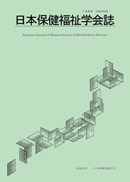Volume 29, Issue 1
Displaying 1-11 of 11 articles from this issue
- |<
- <
- 1
- >
- >|
-
2022 Volume 29 Issue 1 Pages cover1-
Published: October 31, 2022
Released on J-STAGE: September 13, 2023
Download PDF (916K) -
2022 Volume 29 Issue 1 Pages cover2-
Published: October 31, 2022
Released on J-STAGE: September 13, 2023
Download PDF (916K)
-
2022 Volume 29 Issue 1 Pages 1-13
Published: October 31, 2022
Released on J-STAGE: September 13, 2023
Download PDF (946K) -
2022 Volume 29 Issue 1 Pages 15-23
Published: October 31, 2022
Released on J-STAGE: September 13, 2023
Download PDF (871K)
-
Article type: other
2022 Volume 29 Issue 1 Pages 25-27
Published: October 31, 2022
Released on J-STAGE: September 13, 2023
Download PDF (380K) -
Article type: other
2022 Volume 29 Issue 1 Pages 28-29
Published: October 31, 2022
Released on J-STAGE: September 13, 2023
Download PDF (379K) -
Article type: other
2022 Volume 29 Issue 1 Pages 30-32
Published: October 31, 2022
Released on J-STAGE: September 13, 2023
Download PDF (383K) -
Article type: other
2022 Volume 29 Issue 1 Pages 33-38
Published: October 31, 2022
Released on J-STAGE: September 13, 2023
Download PDF (450K) -
Article type: other
2022 Volume 29 Issue 1 Pages 39
Published: October 31, 2022
Released on J-STAGE: September 13, 2023
Download PDF (379K)
-
2022 Volume 29 Issue 1 Pages cover3-
Published: October 31, 2022
Released on J-STAGE: September 13, 2023
Download PDF (517K) -
2022 Volume 29 Issue 1 Pages cover4-
Published: October 31, 2022
Released on J-STAGE: September 13, 2023
Download PDF (557K)
- |<
- <
- 1
- >
- >|
